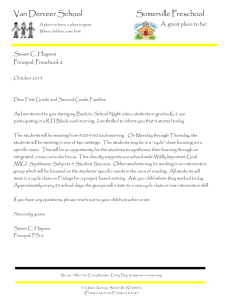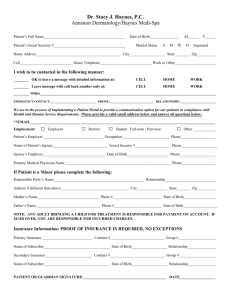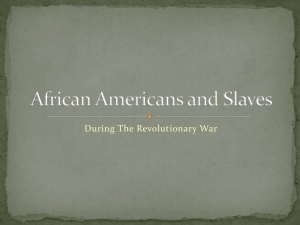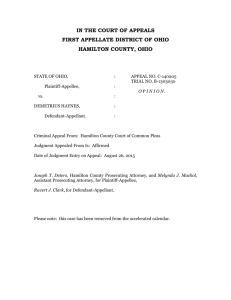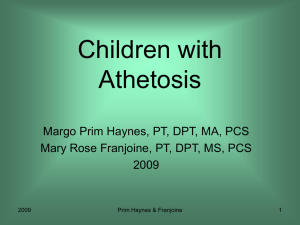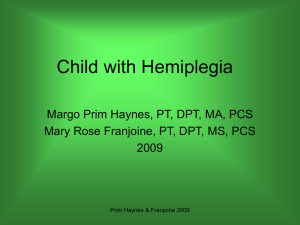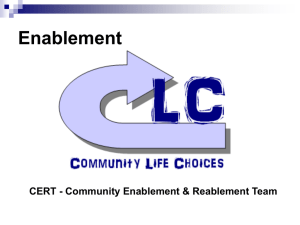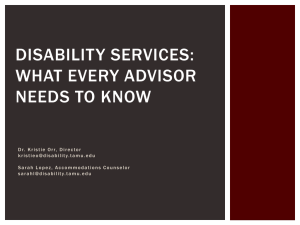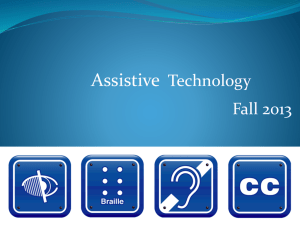NDT Enablement Model
advertisement
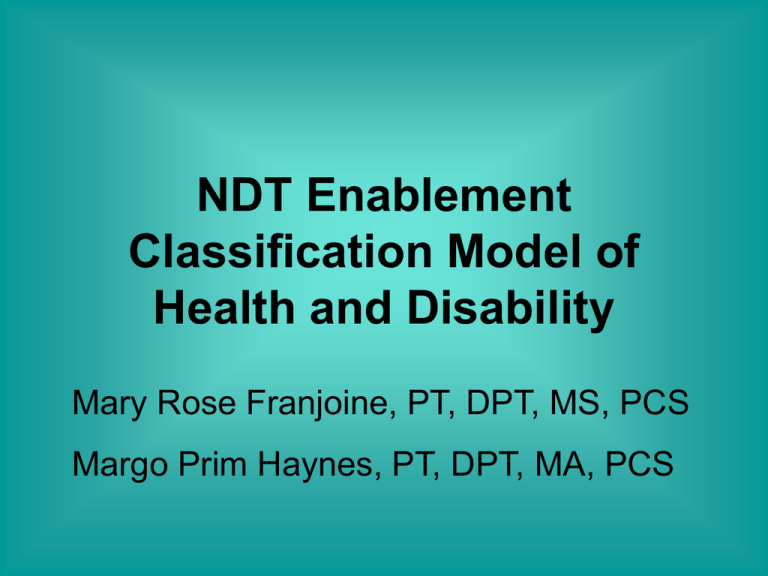
NDT Enablement Classification Model of Health and Disability Mary Rose Franjoine, PT, DPT, MS, PCS Margo Prim Haynes, PT, DPT, MA, PCS Readings & References Required Reading: • Neuro-Developmental Treatment Approach Theoretical Foundations and Principles of Clinical Practice Chapter 2 References: • www.who.org • Neuro-Developmental Treatment Approach Theoretical Foundations and Principles of Clinical Practice Assignment: • Study Guide: – Learning Activity 2.1.1 (pg 83-85) – Learning Activity 1.1.5 (pg 91) 2009 M R Franjoine & M P Haynes 2 Evolutionary Process Disablement Models • WHO & Nagi Disablement frameworks • NCMRR Disablement Model – – – – – Pathophysiology Impairments Functional Limitations Disability Societal Limitations Enablement Models • International Classification of Function, Disability, and Health • NDT Enablement Classification Model of Health and Disability 3 Enablement Frameworks, WHY? • • • • Universal, all inclusive model Multi-dimensional Cross Cultural Social and Medical 2009 M R Franjoine & M P Haynes 4 Dimensions NDT Enablement Classification Model of Health and Disability + Domains Dimension Functional Domain Disability Domain A. Body structure & functions Structural & functional integrity Impairments A.Primary B.Secondary B. Motor functions Effective posture & movement Ineffective posture & movement C. Individual functions Functional activities Functional activity limitations D. Social functions Participation Participation restriction From: NDT Approach Theoretical Foundations & Principles of Clinical Practice, Table 2.1 pg. 82 2009 M R Franjoine & M P Haynes 5 Participation • Nature and extent of a person’s involvement in life situations • Example: Going to the mall on Saturday afternoon with your friends to “hang” 2009 M R Franjoine & M P Haynes 6 Participation Restrictions • Problem an individual may have in the manner or extent of involvement in life • Example: Can’t “hang” at the mall on Saturday afternoon, because: • Can’t walk fast enough • Can’t walk safe enough • Can’t walk and talk 2009 M R Franjoine & M P Haynes 7 Functional Activities • Directly observable functions • Performance of a task or action by the individual. • Example: Able to get the toy 2009 M R Franjoine & M P Haynes 8 Functional Limitations • Difficulties or inability an individual may have in performing a task or function. • Example: Unable to get the toy • Can’t roll over to get toy • Can’t belly crawl to get the toy • Can’t reach to get the toy 2009 M R Franjoine & M P Haynes 9 Posture & Movement Behaviors • Directly observable • Interaction of the systems & the environment • Examples: • Sitting with PPT • Reaching overhead with IR in shoulder, pronated forearm, and fisted hand • Toe walking • Rib cage elevation during expiration 2009 M R Franjoine & M P Haynes 10 Is the Posture and Movement Behavior Effective or Ineffective? Consider: • Alignment • Weight bearing • Postural Control • Balance • Coordination • Motor planning – Temporal – Spatial • Tone • Movement combinations 2009 M R Franjoine & M P Haynes 11 Single Systems • Body Functions – The physiological or psychological functions of the body system • Body Structure – The anatomical parts of the body such as organs, limbs and their components 2009 M R Franjoine & M P Haynes 12 Body Functions • • • • • • • • Mental function Sensory function and pain Voice and Speech functions Functions of Cardiovascular, Hematological, Immunological and Respiratory systems Functions of the Digestive, Metabolic and Endocrine systems Genitounitary and Reproductive functions Neuromusculoskeletal and Movement-related functions Functions of the Skin and related structures 2009 M R Franjoine & M P Haynes 13 Body Structures • • • • • • • • Structures of the nervous system The eye, ear and related structures Structures involved in voice and speech Structures related to the Cardiovascular, Hematological, Immunological and Respiratory systems Structures related to the Digestive, Metabolic and Endocrine systems Structures related to the Genitounitary and Reproductive systems Structures related to Movement Skin and related structures 2009 M R Franjoine & M P Haynes 14 Impairments Problems in a body function or structure • Single system impairments • Multi-system impairments • Can be temporary or permanent • Can change over time Progression Regression 2009 M R Franjoine & M P Haynes 15 Primary Impairments • Can be single or multi-system • Are a direct result of the Body Function or Body Structure injury, dysfunction, or absence. • Positive Behaviors that are present • Negative Behaviors that are absent 2009 M R Franjoine & M P Haynes 16 Secondary Impairments • Can be single or multi-system • Are an indirect result of the Body Function or • Body Structure injury, dysfunction, or absence. 2009 M R Franjoine & M P Haynes 17 Examples Neuromuscular System Primary Positive Impairments • • • • • • • 2009 Spasticity Impaired muscle activation Excessive co-activation Stereotypic, atypical movement synergies Impaired motor execution Incorrect scaling of muscle force Inter-limb and Intra-limb dyscoordination M R Franjoine & M P Haynes 18 Examples Neuromuscular System Primary Negative Impairments • • • • Insufficient force generation (weakness) Impaired anticipatory balance Hypokinesia No fractionated movements 2009 M R Franjoine & M P Haynes 19 Examples Sensory - Perceptual System Primary Positive Impairments • Inaccurate Registration • Inaccurate Modulation • Inaccurate Response 2009 M R Franjoine & M P Haynes 20 Contextual Factors Environmental Physical, social, and attitudinal environment in which people live and function. Examples: • Facilitators • Excellent medical coverage for AT • Barriers • A home environment where children are to be quiet and well behaved at all times 2009 Personal Features of the individual that are not part of a health condition or functional state. Examples: • Facilitators • Outgoing personality • Barriers • Shy, quiet M R Franjoine & M P Haynes 21 Contextual Factors • • • • • Can interact at any level within the model Can come from within the person From the family Can be cultural Can be environmental 2009 M R Franjoine & M P Haynes 22 NDT Enablement Classification Model of Health and Disability Mary Rose Franjoine, PT, DPT, MS, PCS Margo Prim Haynes, PT, DPT, MA, PCS
